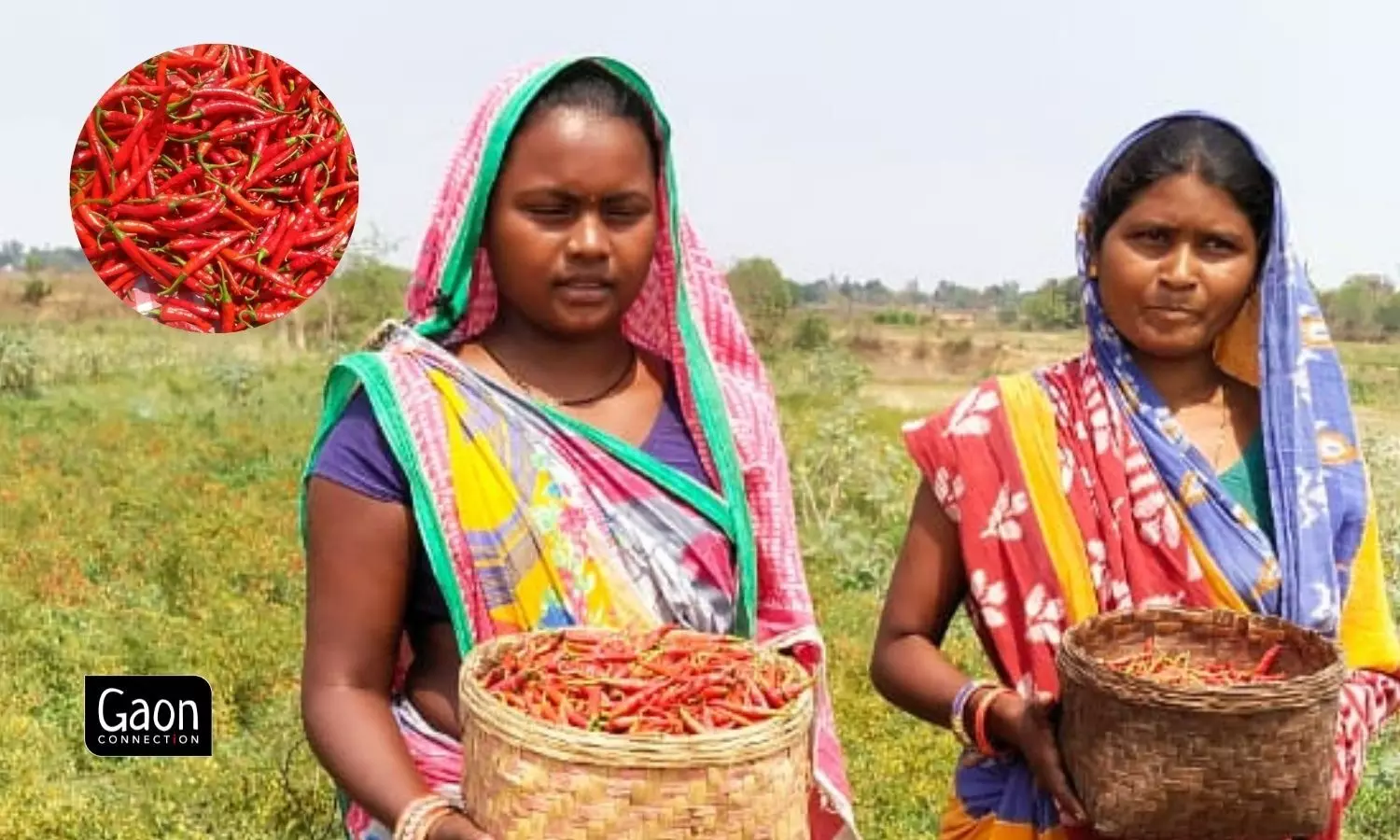Kuchinda chillis add spice to farming in Odisha
Red chilli farming is transforming the lives of farmers from Kuchinda block and its nearby areas in Odisha’s Sambalpur district. The superior quality of the produce has traders and big export companies queuing up at their doorstep.
 Ashis Senapati 24 Jun 2022 6:11 AM GMT
Ashis Senapati 24 Jun 2022 6:11 AM GMT

Farmers in Odisha have switched from the traditional paddy cultivation to chilli and are reaping benefits. All photos: Tapan Das.
More and more farmers in Kuchinda block, Sambalpur district, in Odisha are changing over to chilli cultivation. While traditionally many of them grew paddy, the red chillies are bringing them more cheer.
"Traders are camping in our village waiting to purchase the red chillies from us," Santosh Kisan, a 45-year-old farmer from Kira village, told Gaon Connection, happily.
According to Purusotam Sahoo, the agricultural officer of Kuchinda, 10 years ago, about 7,000 acres (2832.799 hectares) of chilli were cultivated in Kuchinda. Now, 12,000 acres (4856.2277 hectares) of land in Kuchinda block and nearby Bamara is under chilli cultivation. Around 10,000 farmers grow chillies in the area, Sahoo said.
"Things were not so happy during the pandemic when the price of chillies dropped to Rs 80 a kilo. But now, all is well as they are selling for as much as Rs 180 a kg," the agricultural officer added.
Also Read: This summer, ice apple growers in Odisha make hay while the sun shines
"Kuchinda with its warm and humid climate is ideal for chilli cultivation," Himanshu Sekhar Mohapatra, a chilli farmer of Kirasasan village, told Gaon Connection.
"Chilli growers have a large scope of profit because they harvest 10 quintals of dry chilli per acre, and the farmer can earn a good profit," Himahshu explained.
Pabitra Majhi of Dumamunda village did just that. "In 2021, I sowed red chilli for the first time. I grew it on an acre of land and made a lakh of rupees as profit," the 45-year-old chilli farmer said. The crop is low maintenance and needs less water compared to paddy, and farmers can harvest it once a year, he added.
More and more farmers in Kuchinda block, Sambalpur district, in Odisha are changing over to chilli cultivation.
According to farmer Kiran Mohapatra of Kirasasan village, red chilli has a huge demand and many companies are ready to pay a good price. "Many of us have switched from the traditional paddy cultivation to chilli and we are reaping the benefits," the 58-year-old told Gaon Connection.
The Odisha Rural Development And Marketing Society (ORMAS) and the Kuchinda Regulated Market Committee are providing ample support to the chilli farmers. "We are helping them with proper market linkages," Manoj Mahanta, secretary, Kuchinda Regulated Market Committee, told Gaon Connection.
The secretary pointed out how the area was once infamous for people migrating to find alternative livelihoods, but now with the filip to chilli farming, migration had slowed down to a great extent. "Chilli farming has resulted in almost immediate prosperity for the people," Mahanta said.
The superior quality of the produce has traders and big export companies queuing up at the doorstep of farmers.
Kuchinda chillies got a further boost when the Spices Board of India (SBI) , Kochi, in Kerala, tested the Kuchinda chilli and found it far superior in quality when compared to other parts of the country. "The report was published after the ORMAS sent some samples to the lab for quality testing and we have urged the state government to apply for a GI (Geographical Indication) tag for the Kuchinda red chillies," said Mahanta.
After the test reports were published some major export companies have shown interest in purchasing them, Mahanta revealed.
While the prosperity from the Kuchida chillies may be a more recent phenomena, their cultivation goes back to 1901 when the Raja of Bamarda had encouraged some farmers to raise chilli instead of paddy crops to combat erratic and deficit rainfall. "Only 10 per cent of the rain required for paddy cultivation is needed for the chillis," Mahanta said.
Also Read: Organic ginger prices crash leaving farmers in Koraput in distress
#odisha #farming #story
More Stories




